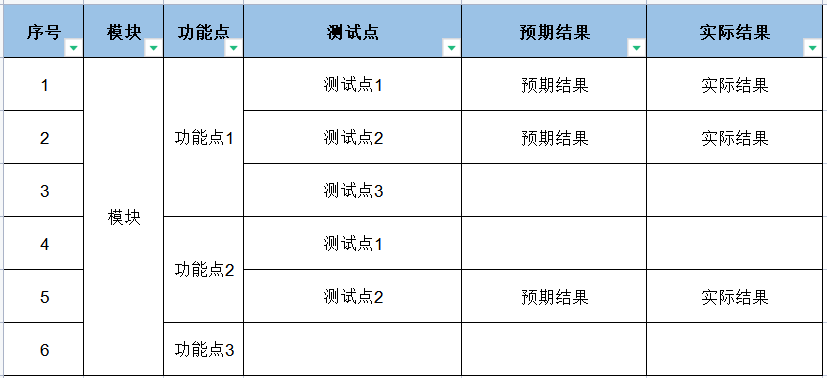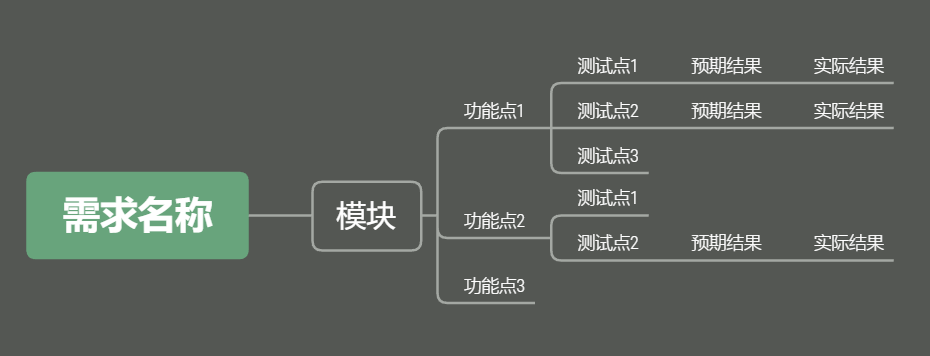转载请注明出处❤️
作者:测试蔡坨坨
原文链接:caituotuo.top/c2d10f21.html
你好,我是测试蔡坨坨。
今天分享一个Python编写的小工具,实现XMind测试用例转Excel用例。
前言 XMind和Excel是在日常测试工作中最常用的两种用例编写形式,两者也有各自的优缺点。
使用XMind编写测试用例更有利于测试思路的梳理,以及更加便捷高效,用例评审效率更高,但是由于每个人使用XMind的方式不同,设计思路也不一样,可能就不便于其他人执行和维护。
使用Excel编写测试用例由于有固定的模板,所以可能更加形式化和规范化,更利于用例管理和维护,以及让其他人更容易执行用例,但是最大的缺点就是需要花费更多的时间成本。
由于项目需要,需要提供Excel形式的测试用例,同时编写两种形式的测试用例显然加大了工作量,于是写了个Python脚本,可快速将XMind用例转换成Excel用例。
设计思路 Excel测试用例模板样式如下图所示:
表头固定字段:序号、模块、功能点
为了让脚本更加灵活,后面的字段会根据XMind中每一个分支的长度自增,例如:测试点/用例标题、预期结果、实际结果、前置条件、操作步骤、优先级、编写人、执行人等
根据Excel模板编写对应的XMind测试用例:
实现:
将XMind中的每一条分支作为一条序号的用例,再将每个字段写入Excel中的每一个单元格中
再手动调整美化一下表格:
完整代码 源码获取方式:关注公众号测试蔡坨坨 ,回复关键词源码
1 2 3 4 5 6 7 8 9 10 11 12 13 14 15 16 17 18 19 20 21 22 23 24 25 26 27 28 29 30 31 32 33 34 35 36 37 38 39 40 41 42 43 44 45 46 47 48 49 50 51 52 53 54 55 56 57 58 59 60 61 62 63 64 65 66 67 68 69 70 71 72 73 74 75 76 77 78 79 80 81 82 83 84 85 from typing import List, Anyimport xlwtfrom xmindparser import xmind_to_dictdef resolve_path (dict_, lists, title ): """ 通过递归取出每个主分支下的所有小分支并将其作为一个列表 :param dict_: :param lists: :param title: :return: """ title = title.strip() if len (title) == 0 : concat_title = dict_["title" ].strip() else : concat_title = title + "\t" + dict_["title" ].strip() if not dict_.__contains__("topics" ): lists.append(concat_title) else : for d in dict_["topics" ]: resolve_path(d, lists, concat_title) def xmind_to_excel (list_, excel_path ): f = xlwt.Workbook() sheet = f.add_sheet("XX模块" , cell_overwrite_ok=True ) row_header = ["序号" , "模块" , "功能点" ] for i in range (0 , len (row_header)): sheet.write(0 , i, row_header[i]) index = 0 for h in range (0 , len (list_)): lists: List[Any] = [] resolve_path(list_[h], lists, "" ) for j in range (0 , len (lists)): lists[j] = lists[j].split('\t' ) for n in range (0 , len (lists[j])): sheet.write(j + index + 1 , 0 , j + index + 1 ) sheet.write(j + index + 1 , n + 1 , lists[j][n]) if n >= 2 : sheet.write(0 , n + 1 , "自定义" + str (n - 1 )) if j == len (lists) - 1 : index += len (lists) f.save(excel_path) def run (xmind_path ): xmind_dict = xmind_to_dict(xmind_path) excel_name = xmind_path.split('\\' )[-1 ].split("." )[0 ] + '.xlsx' excel_path = "\\" .join(xmind_path.split('\\' )[:-1 ]) + "\\" + excel_name print(excel_path) xmind_to_excel(xmind_dict[0 ]['topic' ]['topics' ], excel_path) if __name__ == '__main__' : xmind_path_ = r"F:\Desktop\coder\python_operate_files\用例模板.xmind" run(xmind_path_)
代码解析 1. 调用xmind_to_dict()方法将XMind中所有内容取出并转成字典 1 xmind_dict = xmind_to_dict(xmind_path)
1 [{'title': '画布 1', 'topic': {'title': '需求名称', 'topics': [{'title': '模块', 'topics': [{'title': '功能点1', 'topics': [{'title': '测试点1', 'topics': [{'title': '预期结果', 'topics': [{'title': '实际结果'}]}]}, {'title': '测试点2', 'topics': [{'title': '预期结果', 'topics': [{'title': '实际结果'}]}]}, {'title': '测试点3'}]}, {'title': '功能点2', 'topics': [{'title': '测试点1'}, {'title': '测试点2', 'topics': [{'title': '预期结果', 'topics': [{'title': '实际结果'}]}]}]}, {'title': '功能点3'}]}]}, 'structure': 'org.xmind.ui.logic.right'}]
2. 通过切片得到所有分支的内容 1 xmind_dict[0 ]['topic' ]['topics' ]
1 [{'title': '模块', 'topics': [{'title': '功能点1', 'topics': [{'title': '测试点1', 'topics': [{'title': '预期结果', 'topics': [{'title': '实际结果'}]}]}, {'title': '测试点2', 'topics': [{'title': '预期结果', 'topics': [{'title': '实际结果'}]}]}, {'title': '测试点3'}]}, {'title': '功能点2', 'topics': [{'title': '测试点1'}, {'title': '测试点2', 'topics': [{'title': '预期结果', 'topics': [{'title': '实际结果'}]}]}]}, {'title': '功能点3'}]}]
3. 通过递归取出每个主分支下的所有小分支并将其作为一个列表 1 2 3 4 5 6 7 8 9 10 11 12 13 14 15 16 17 18 19 20 def resolve_path (dict_, lists, title ): """ 通过递归取出每个主分支下的所有小分支并将其作为一个列表 :param dict_: :param lists: :param title: :return: """ title = title.strip() if len (title) == 0 : concat_title = dict_["title" ].strip() else : concat_title = title + "\t" + dict_["title" ].strip() if not dict_.__contains__("topics" ): lists.append(concat_title) else : for d in dict_["topics" ]: resolve_path(d, lists, concat_title)
1 2 3 4 5 6 7 8 9 10 for h in range (0 , len (list_)): lists: List[Any] = [] resolve_path(list_[h], lists, "" ) print(lists) print('\n' .join(lists)) for j in range (0 , len (lists)): lists[j] = lists[j].split('\t' ) print(lists[j])
1 2 3 4 5 6 7 8 9 10 11 12 13 14 15 16 17 18 lists: ['模块\t功能点1\t测试点1\t预期结果\t实际结果', '模块\t功能点1\t测试点2\t预期结果\t实际结果', '模块\t功能点1\t测试点3', '模块\t功能点2\t测试点1', '模块\t功能点2\t测试点2\t预期结果\t实际结果', '模块\t功能点3'] 主分支下的小分支: 模块 功能点1 测试点1 预期结果 实际结果 模块 功能点1 测试点2 预期结果 实际结果 模块 功能点1 测试点3 模块 功能点2 测试点1 模块 功能点2 测试点2 预期结果 实际结果 模块 功能点3 将主分支下的小分支构成列表: ['模块', '功能点1', '测试点1', '预期结果', '实际结果'] ['模块', '功能点1', '测试点2', '预期结果', '实际结果'] ['模块', '功能点1', '测试点3'] ['模块', '功能点2', '测试点1'] ['模块', '功能点2', '测试点2', '预期结果', '实际结果'] ['模块', '功能点3']
4. 写入Excel(生成单sheet的Excel文件、生成固定的表头标题、列序号取值、固定标题外的自定义标题) 1 2 3 4 5 6 7 8 f = xlwt.Workbook() sheet = f.add_sheet("签署模块" , cell_overwrite_ok=True ) row_header = ["序号" , "模块" , "功能点" ] for i in range (0 , len (row_header)): sheet.write(0 , i, row_header[i])
1 2 3 4 5 6 7 8 for n in range (0 , len (lists[j])): sheet.write(j + index + 1 , 0 , j + index + 1 ) sheet.write(j + index + 1 , n + 1 , lists[j][n]) if n >= 2 : sheet.write(0 , n + 1 , "自定义" + str (n - 1 ))












